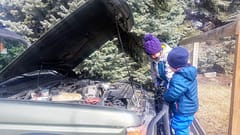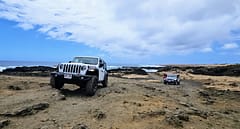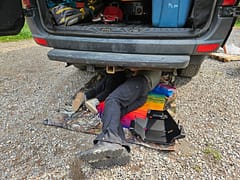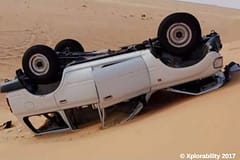Diagnosing Knocking Noise from Front End of Land Rover Discovery 2
Failed Shock
Contents
Introduction
We heard the knocking noise best when driving in our back alley, slowly on the bumpy road. We also heard it well when driving high speeds on a hwy hitting the fine bumps of the pavement. The knocking sounded sort of like a chirping noise. We thought it was coming from the suspension, now we just had to figure out if we were right.
Mechanics in Training - Always Ready to Help

After extensive YouTube and Google research on solid axle front suspension faults and fixes. It was clear that Jeeps, Ford F250s and 350s, Land Rovers and other solid axle vehicles can use the same trouble shooting process.
No Jack Diagnosis
The most common technique for diagnosing these problems required two people. One person will be in the driver seat while the other person will be underneath the front of the car. With the vehicle running (e- brake on!), the steering wheel needs to be turned back and forth repeatedly while the person under the vehicle observes all of the ball joints for any play. If the play is not immediately visible it may be necessary to put your hand on the joints themselves to feel if there is any separation between the ball joints that might be causing a noise while driving. This might be associated to the ball joints on your track rod, the drag link,or the bushings of your pan hard rod or steering stabilizer. If nothing is detected through this test, the next test will be to turn the steering wheel from one side lock all the way to the other while the person under the vehicle is listening for any sounds coming from the CV joint. If nothing is audible through this method the next step is to press down on the front end of the vehicle - on either side of the vehicle and in the center to see if any sounds are coming from the shocks. Sometimes shock noises can be really hard to recreate while the vehicle is stationary. If you have a steel bumper and jump up and down to try and create the noise. You can also use your legs to push up on your bumper to move the car up and down if you’re by yourself. I have used the up and down pushing technique to find loose and squeaky anti sway links.
Instead of the above testing you can jack the vehicle up on the front axle. Put hands on 3 and 9 on the wheel and push the wheel back and forth if it indicates play (in track rod or drag link). We did this too and felt play. Then 12 and 6 positions (pushing and pulling back and forth). Any play will indicate loose ball joints
Jacked Up Vehicle Diagnosis
We couldn’t re-create the knocking in any of the above processes. Though we did discover our track rod and drag link had some slight play and decided to replace, link to track rod replacement article. This did not take away the knocking noise but made our steering tighter and more accurate.
We still had the knocking (drove my husband crazy) decided to try something different to stop ourselves going crazy trying to figure out what was wrong. The only possible options at this point for the knocking was a shock that was failing, a worn shock bushing or a slight possibility of a bad CV joint (based on lack of findings in tests above).
At this point the easiest thing to do was replace the shocks as they are relatively cheap ~$200 and they do fail after a couple of years in our experience. You’ll find plenty of videos that show this fix but the quick summary is to remove the air intake assembly and coolant resevoir to get access to the shock towers. Remove top and bottom bolts of the shock and replace. Relatively easy fix as the wheels can be left on while doing this.
In our case we noticed that the spring on the passenger side of the vehicle had spun out of their seating groove. Since it was so jammed in we had to jack vehicle up high enough to remove the pressure from spring to spin it into place. Of course to get the body high enough we had remove the front drive shaft which is always fun to do when you were only expecting to replace a couple of shocks. After all was done though it feels good to have a vehicle that has all its parts nicely in their places.
During all of these processes it’s also nice to clean up the engine bay and throttle body openings that are normally hard to reach with the coolant reservoir and air intake assembly moved. Once all was fitted no more noise…HURRAY!
And for some humor, we decided to attach a GoPro to the wheel well to see if we could better hear where the knocking noise was coming from. We could only capture the noise a few times but maybe the footage could be used as a new type of white noise to put kids to sleep.





